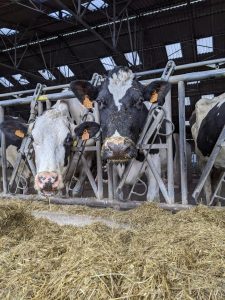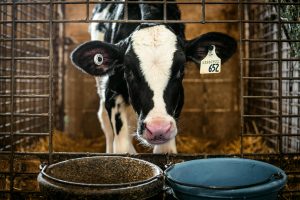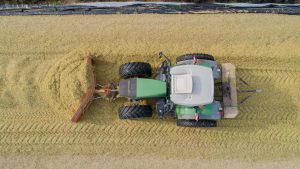Álvaro García
In modern cattle feeding, the term “probiotic” is widely recognized. Many nutritionists, veterinarians, and producers routinely refer to probiotics when addressing challenges related to gut health, feed efficiency, immune function, or calf development. These beneficial microbes have earned their place in dairy and beef nutrition programs due to their demonstrated ability to stabilize the rumen environment, reduce pathogen load, and improve nutrient absorption, particularly during times of stress or transition.
However, as the science of microbial nutrition advances, new categories of bioactive compounds are emerging. One such development is the growing interest in postbiotics, compounds produced by bacteria, or derived from their breakdown, that can offer health benefits to the animal even though the bacteria themselves are no longer alive. These ingredients are gaining momentum due to their stability, safety, and potential for targeted functionality across different production phases.
So what exactly are postbiotics, and how do they differ from the live microbial supplements most producers are familiar with? To answer that, it helps to revisit the foundations of probiotics and prebiotics before exploring what postbiotics can offer in ruminant nutrition.
Prebiotics: Fueling the right microbes
While not the focus of this article, it is important to distinguish prebiotics from both probiotics and postbiotics. Prebiotics are non-digestible feed components, such as certain oligosaccharides and fiber fractions, that escape digestion by the cow’s enzymes. Instead, they are fermented by beneficial microbes in the gut. Despite being “non-digestible” to the cow itself, prebiotics serve as food for beneficial bacteria, promoting their growth and activity. As these microbes’ ferment prebiotic substances, they produce short-chain fatty acids (SCFAs) like butyrate, acetate, and propionate, which support intestinal health, lower gut pH to suppress pathogens, and contribute to energy supply. Prebiotics help shape a favorable microbial environment without introducing new organisms.
Live microbes with functional purpose
Let us begin with probiotics which are live microorganisms that, when administered in adequate amounts, deliver a health benefit to the host (Hill et al., 2014). In cattle, probiotics are typically used to support gut microbial balance, enhance fiber digestion, and promote rumen stability, particularly during stressful periods such as calving, ration transitions, or transport.
Among the most used probiotic microbes are Lactobacillus species, which help suppress harmful bacteria through lactic acid production, and Enterococcus faecium, known for its role in immune modulation. Yeasts like Saccharomyces cerevisiae are valued for their ability to stabilize rumen pH and boost fiber breakdown, while spore-forming Bacillus species stand out for their resilience and potential to aid digestion beyond the rumen, particularly in the small intestine. These organisms work through a variety of mechanisms: colonizing specific regions of the gastrointestinal tract, producing beneficial compounds, stimulating immune responses, and limiting the growth of pathogens. The increased interest in probiotics reflects the shift toward non-antibiotic strategies that enhance microbial diversity, nutrient absorption, and animal resilience, often through well-researched strains like Bacillus subtilis, Lactobacillus plantarum, and Bifidobacterium species (García, 2025).
Functionality without the living cell
In contrast to probiotics, postbiotics are not alive. This group includes inactivated microbial cells, structural fragments, and metabolic byproducts that still benefit the animal. As defined by Salminen et al. (2021), postbiotics function without needing to survive the digestive tract or rumen, which gives them advantages in stability and safety.
The active components of postbiotics may include short-chain fatty acids like acetate, propionate, and butyrate, all key players in gut health and energy metabolism, as well as organic acids, enzymes, antimicrobial peptides (such as bacteriocins), and inactivated microbial biomass. Even fragments like peptidoglycans from cell walls can have immune-stimulating effects. Heat-killed strains of Lactobacillus or Bacillus can be used for this purpose, delivering benefits without the variability or storage challenges of live cultures. Because they don’t rely on viability, postbiotics are more compatible with pelleted feeds and harsh storage conditions, and they pose no risk of unintended microbial contamination, making them an increasingly attractive tool in modern ruminant nutrition.
How postbiotics work—and why they’re gaining ground in cattle nutrition
Postbiotics can influence multiple points along the digestive tract and even exert systemic effects beyond the gut. In the rumen, microbial enzymes and fermentation byproducts may help improve fiber breakdown and shift volatile fatty acid profiles toward more efficient energy use. Moving further down the tract, in the hindgut, certain antimicrobial metabolites and bacterial cell wall fragments can modulate the microbial balance and prevent harmful bacteria from attaching to the gut lining. Some postbiotic components, such as peptidoglycans or lipoteichoic acids, can also engage with receptors like Toll-like receptors in the intestinal lining, which play a role in regulating immune responses and reinforcing gut barrier function (Aguilar-Toalá et al., 2018).
What makes postbiotics especially appealing in cattle feeding is their stability and flexibility. Unlike live probiotics, they do not require refrigeration, are unaffected by pelleting temperatures, and can be safely included in mineral supplements or total mixed rations. Their lack of viability also means they can be used in conjunction with antibiotics without risk of microbial competition or disruption. Formulations can be tailored to meet specific production goals, such as supporting calf health through weaning, enhancing digestion in high-producing dairy cows, or promoting immunity under stress. Additionally, postbiotics align well with growing consumer interest in non-antibiotic, functional feed ingredients and offer a low biosecurity risk since no live organisms are involved.
Postbiotics are not a replacement for probiotics but rather a complementary strategy that builds on the microbial tools already used in modern cattle nutrition. They deliver many of the same benefits associated with microbial activity, such as improved gut function, immune modulation, and digestive support, but without the risks or limitations of live-cell viability. Their stability in feed processing, compatibility with other additives, and targeted modes of action make them especially appealing in rations for calves, transition cows, or high-producing dairy herds.
As our understanding of microbial-derived compounds deepens, postbiotics are likely to play an increasingly important role in sustainable, non-antibiotic nutrition programs. For producers already familiar with the value of probiotics, the next logical step is to explore what these microbes can leave behind, and how postbiotics might enhance animal health and performance in your herd.
© 2025 Dellait Knowledge Center. All Rights Reserved.









